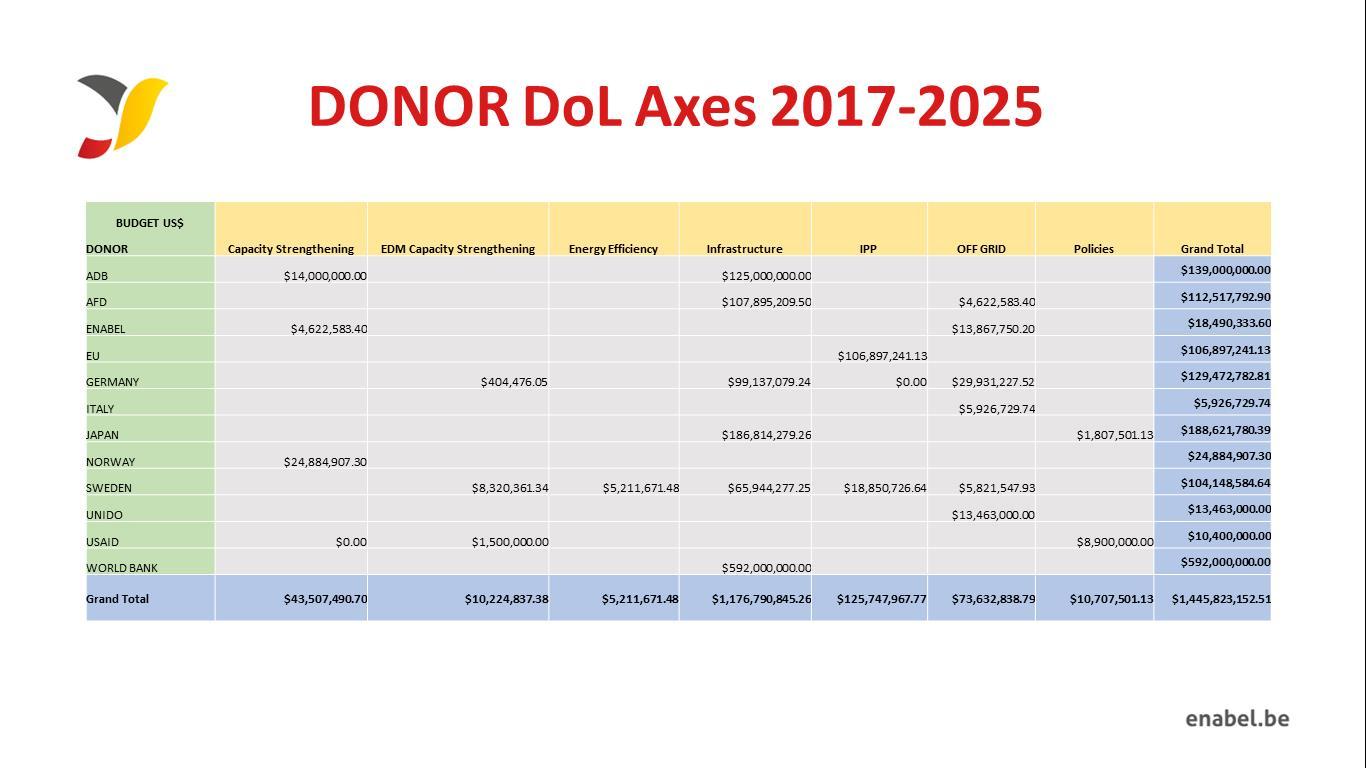Strengthening coordination in the supply and demand of aid to Mozambique’s energy sector
Strengthening coordination
in the supply and demand of aid to Mozambique’s energy sector
By E.Waeterloos and A.Van de Velde, Enabel Mozambique
Over the past years the energy
sector in Mozambique has gone through various transitions. This changing
context has created new challenges and affected the responsibilities, needs and
resources of key stakeholders. With various new donors providing assistance to
the energy sector, possible overlaps and complementarities need to be reconsidered.
Enabel supports some of Mozambique’s most important governmental actors to build
their institutional and operational capacity and to stimulate complementarity, coordination
and even division of labour[1]
among international and local stakeholders.
An evolving sector
End 2017, HE E.M. Tonela was appointed
as new Minister of Mineral Resources and Energy. As economist and previous
board member of the Hidroelectrica de Cahora Bassa (HCB), Mr. Tonela brings
expertise from the private energy sector. In December 2017, the new Energy
Regulatory Authority (ARENE) replaced the previous advisory CNELEC and is now responsible
for the supervision and regulation of production, transport, distribution,
commercialization and storage of electricity from any source of energy. Moreover,
in 2018 a range of new energy polices has been developed. The adoption of the National Electrification
Strategy (ENE) was an important step in Mozambique’s strategy to achieve
universal access to electricity by 2030 and clearly identifies the three main
challenges in achieving this: institutional (lack of planning and
coordination), financial (operating and connecting costs) and technical
(reliability of the system). In October 2018, the Mozambican government also
approved the Integrated Master Plan for electricity infrastructure. It is an
ambitious plan aimed at increasing the country’s capacity to generate, consume
and export electricity over the next quarter of a century. Furthermore, the
Electricity Law of 1997 is under revision and aims to promote the efficiency of
the electricity sector, encourage greater participation of the private sector
and establish tariff mechanisms. Lastly, the discovery of immense natural gas and
oil reserves a decade ago may improve the country’s macro-economic situation
and living standards of the population, but at the same time triggered poor
government decisions leading to an accumulation of unsustainable levels of debt
(secret loans) and strained donor relations. In short, the energy sector in
Mozambique evolves in different dimensions in terms of supply and demand of
renewable and non-renewable energy. These changes lead to a situation in which
the various key national and international stakeholders need to adapt to their
new roles and set up better coordination mechanisms.
Surveying aid supply and demand in the sector
The technical assistance provided
through Enabel’s capacity building project “CB MIREME” supports the Ministry of
Mineral Resources and Energy (MIREME), its provincial directorates (DIPREME)
and ARENE to cope better with their new role, responsibilities and the changing
context. Early in 2018, MIREME formulated an urgent demand through the Energy
Sector Working Group (ESWG) - the donor-government policy dialogue and
interface platform - to obtain an updated overview of donor activities and
commitments in the electric energy sector and to explore possibilities for
better coordination. Enabel collected data through a structured questionnaire between
the 14th of June and the 23rd of July 2018. Through the ESWG,
22 potential donors were contacted of which more than half (14) eventually responded.
The objective of this snap survey is to improve planning, alignment, and coordination
between the Mozambican government, donors, and other key partners. A
preliminary analysis was presented at the donor coordination meeting on the 5th
of July 2018, organized and financed by Enabel in collaboration with MIREME and
ESWG. This brief summarizes the most important findings of the final analysis.
For the period 2017 to
2025, 12 donors reported 45 projects earmarked for Mozambique’s energy sector
with a total reported financial supply of almost US$ 1.5 billion. Twenty five
projects are already operational, while 19 have not yet been signed and are
still in the pipeline. This means that with an equivalent of almost US$ 900
million, the majority of funding between 2017 and 2025 is not yet formally
committed. These donor interventions are situated in a variety of areas, with investment
in grid infrastructure (US$1.2 billion) and the promotion of independent power
producers (IPP) (US$ 126 million) as frontrunners. The other intervention areas
are in order of importance: promotion of off-grid technologies, general
capacity strengthening of the sector’s actors, capacity strengthening of the government-owned
utility responsible for generation, transmission and distribution of
electricity through the national grid EDM, support to the development of sector
policies and strategies, and the promotion of energy efficiency. Sweden has the
most diverse portfolio with 10 projects in five of the seven intervention areas
and is the main sponsor of capacity strengthening in EDM, as well as the only donor investing in
energy efficiency. The World Bank on the other hand, invests its entire budget in
four projects of building grid infrastructure, while the EU focuses solely on
the promotion of independent power producers. Norway is the biggest investor in
the area of the sector’s general capacity strengthening, while Germany is the donor
with the biggest investments in the off-grid axis; USAID focuses mainly on
policies. The general pattern of flow of funds shows a peak in 2019 – 2020 (US$
215 - 261 million) but no commitments planned after 2023.
As to the demand side
of aid, the data collected from donors does not allow an analysis of each and
every recipient individually. The importance of energy actors in terms of donor
funds received can, however, be determined through an approximation. A donor can
reach several recipients in one single intervention. Therefore, the only
approximation of funds channelled to individual recipients possible is by allocating
each and every time the project’s total financial volume to each recipient listed
in an intervention. Such cumulating of funds obviously results in double
counting in absolute terms, but provides at least a relative weight of every
recipient in the total energy sectors’ funding basket. This can be explained by
the case of EDM: EDM receives the highest financial attention between 2017-25,
both in absolute terms where at least US$ 654 million are directly foreseen for
EDM, as in relative terms, where donor projects which support (among others) EDM
cumulatively amount to US$ 1.3 billion out of a cumulative US$ 2.6 billion. In
the same approximation, projects which support the private sector combine to a
total of US$ 400 million. In relative perspective, FUNAE and MIREME both get
considerably less attention (respectively US$ 233 million and 260 million).
However, it is especially remarkable that the new energy regulator ARENE, civil
society and provincial MIREME directorates (DIPREME) receive less than 2% of
the approximation’s total funding volume
of US$ 2.6 billion.
Challenges to coordination in and between aid supply and demand
Even though this
snap survey lacks detail to identify the exact volume of funds channelled to
individual recipients or to highlight overlaps and conflicts between project
activities and funds, it does provide a first range of pointers on how to improve
coordination among and between donors and recipients. For example, geographical
coverage of funding is unequal, with provinces of Maputo, Inhambane and Gaza
receiving most project funding and Sofala, Cabo Delgado and Niassa the least. Similar
funding inequalities apply to recipient partners (EDM versus ARENE for
instance) and intervention areas (grid infrastructure versus energy efficiency).
Such analysis can further inform discussions on improved coordination and
alignment. The information needs to be
further refined in order to fully support discussions on overlaps, conflicts,
complementarity and division of labour (DoL). The survey should have a wider
coverage and reach out to traditional as well as new donors, include details on
aid modalities (e.g. loan or grant), engage in in-depth interviews with each
donor to determine overlaps and improved DoL, and triangulate and harmonize
information with MIREME and EDM data. It is therefore Enabel’s recommendation
to continue in 2019 with more formal and systematic half-yearly information
gathering and data management under supervision of, for instance, a team comprising
members of the Energy Sector Working Group, MIREME and EDM. Such panel survey complemented
with more qualitative in-depth information can support discussions within
government and within the ESWG on improved alignment and coordination between and
among aid supply and demand.
[1] Division
of labour (DoL) aims at reducing fragmentation of aid by stimulating
coordination and harmonisation among donors, who often concentrate on the same
countries and sectors.
Latest news from this project
No news

